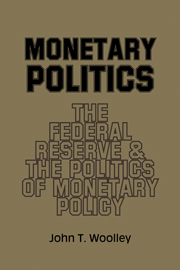Book contents
- Frontmatter
- Contents
- Preface
- 1 The Federal Reserve and the Politics of Monetary Policy: Introduction and Overview
- 2 A Capsule History of the Federal Reserve System
- 3 Recruitment and Selection of Federal Reserve Personnel
- 4 Bankers and the Federal Reserve
- 5 Economists and the Federal Reserve
- 6 The President and the Federal Reserve
- 7 Congress and the Federal Reserve
- 8 Making Monetary Policy in a Political Environment: The Election of 1972
- 9 Monetary Politics: A Summary
- Appendix A A Note on Data Sources
- Appendix B Legislation Included in Table 7.1
- Appendix C Academic Backgrounds and Career Experiences of Notable Monetarists
- Notes
- Bibliographic Note
- Index
1 - The Federal Reserve and the Politics of Monetary Policy: Introduction and Overview
Published online by Cambridge University Press: 01 June 2011
- Frontmatter
- Contents
- Preface
- 1 The Federal Reserve and the Politics of Monetary Policy: Introduction and Overview
- 2 A Capsule History of the Federal Reserve System
- 3 Recruitment and Selection of Federal Reserve Personnel
- 4 Bankers and the Federal Reserve
- 5 Economists and the Federal Reserve
- 6 The President and the Federal Reserve
- 7 Congress and the Federal Reserve
- 8 Making Monetary Policy in a Political Environment: The Election of 1972
- 9 Monetary Politics: A Summary
- Appendix A A Note on Data Sources
- Appendix B Legislation Included in Table 7.1
- Appendix C Academic Backgrounds and Career Experiences of Notable Monetarists
- Notes
- Bibliographic Note
- Index
Summary
Among powerful governmental institutions, the Federal Reserve is surely in the first rank. It is in the first rank because of the policy responsibilities it is assigned – determining monetary aspects of macroeconomic policy and regulating financial institutions. The Federal Reserve is important, and it is increasingly controversial. In the past two decades, there have been repeated new departures in monetary policy in response to economic crises. According to critics, policy has been conducted unsteadily. The Federal Reserve has been accused of destabilizing the economy. It has been criticized for seeming to say one thing and then doing another.
Nevertheless, political scientists have rarely studied the Federal Reserve systematically, and economists have often had to undertake their own bootstrap political analyses of the institution. Perhaps political scientists have been misled because, despite the fact that the Federal Reserve's responsibilities are politically sensitive ones, it is supposedly independent of political influences. Plainly, the Federal Reserve is a key political institution. It defines, sets, and implements public policy in a central arena. It is engaged in conflict that is increasingly overt. Its actions have important consequences for other institutions that political scientists have studied extensively.
This work provides an introductory survey of some political aspects of the Federal Reserve System, particularly the System's relationships with other political actors. There is much work to be done in this area.
- Type
- Chapter
- Information
- Monetary PoliticsThe Federal Reserve and the Politics of Monetary Policy, pp. 1 - 29Publisher: Cambridge University PressPrint publication year: 1984



